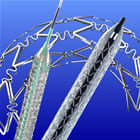|
The data is from the Swedish Coronary Angiography and Angioplasty Registry (SCAAR): unique because in Sweden every patient is assigned a number which is tracked across hospitals and procedures. So this study looked at the outcomes for each of the 61,351 patients in Sweden who had an angioplasty or stent from November 2006 through October 2010. Good News for Everyone: Concerns About DES Reversed However, early fears over the issues of late stent thrombosis (blood clots inside the medicated stents after a year or more) had an immediate effect on the use of drug-eluting stents, which dropped precipitously from the 90% level down to 60-70% and has not yet returned. As it turned out, the initial reports from Sweden of increased death with DES were reversed as time went on (see "About Those Stents: Tiny Time Bombs in Your Heart...or Not?" from the Editor's Stent Blog) and the SCAAR Registry showed that, when those same patients from 2003-2004 were followed for a longer period of time, even the first generation of drug-eluting stents performed better than the bare metal variety. This phenomenon is most likely due to the fact that bare metal stents have a higher restenosis rate and that, over time, this restenosis translates to more complications and repeat procedures. And restenosis presents as a heart attack in a significant number of cases. Second Generation Stents Better Than First and Both Are Better Than Bare Metal Stents The study also found that the new generation of DES was associated with a 38% lower risk of restenosis and a 43% lower risk of stent thrombosis within two years of implantation than BMS. Late stent thrombosis has been a recurring safety concern with the original DES; the authors suggest that the new generation DES, with "thin, more biocompatible polymers" and greater flexibility, may have contributed to lowering this thrombotic risk.
Speaking on behalf of the SCAAR investigators, cardiologist Dr Stefan James from Uppsala University Hospital in Sweden described the latest findings as "intriguing" -- not just because of the lower rates of restenosis with the latest generation of DES, which were expected, but also of stent thrombosis and mortality. "The low rates of restenosis and stent thrombosis correspond with the results of several recent randomized trials," said Dr. James, "and this may well translate into mortality reduction in a sufficiently large study population." Indeed, when the FDA held its two-day emergency panel in December 2006 on the issue of late stent thrombosis in DES, the panel roundly criticized device manufacturer Cordis/J&J for following the initial cohort of 1,000 patients for only one year. Dr. William Maisel was outraged and queried, "Weren't you concerned about what happened to these people at two and three years?" At the same time, the panel complimented Medtronic and Abbott who were in the process of conducting multi-year trials with large numbers of patients. As it turned out, Medtronic did follow its cohort of Endeavor stent patients for five years, and at around year three, their stent surpassed Cordis' CYPHER, showing that there was definitely a late loss effect in the early generation of stents and that, to be accurate, stent studies needed to be done over the long term. Interestingly, Cordis/J&J announced this year that it is discontinuing manufacture of its flagship first generation CYPHER and that the company is withdrawing from the coronary stent market altogether. Boston Scientific has developed several new stents with new designs and thinner struts, although there are concerns over their stent's integrity (see "New Boston Scientific Stent Shows Significant Shortening Compared to Other 2nd Generation DES"). Meanwhile Abbott has emerged as the market leader with its XIENCE stents and Medtronic is awaiting FDA approval of its Resolute zotarolimus-eluting stent, which has been quickly adopted in Europe as it has been shown as equivalent to Abbott's in several trials. The Future of PCI is DES However, given the results of the SCAAR data, it may be difficult to mount randomized trials comparing DES to bare metal stents. At two years, restenosis was 7.4% for the bare metal stents and only 3.9% for second generation DES; and most strikingly, definite stent thrombosis weas 1.4% in bare metal, almost the same for first generation DES, but only 0.6% for the newer DES, less than half the stent thrombosis seen in bare metal stents. Citing these data, Dr. Gregg W. Stone of Columbia University Medical Center was quoted by TCTMD as stating, “People are so confident that the newer drug eluting stents are much more effective than bare metal stents...it would no longer be ethical to randomize most patients.” Reported by Burt Cohen, January 9, 2012 |


